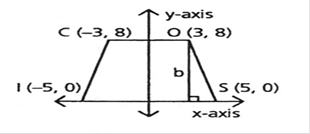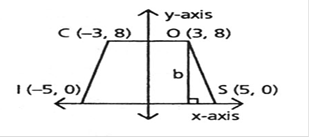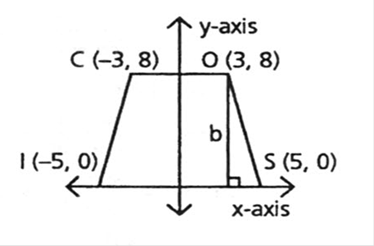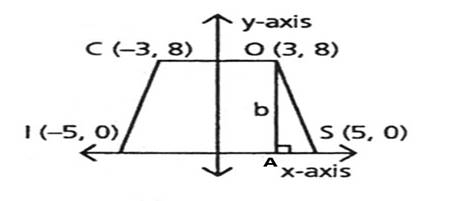
a.
To show: Diagonals
a.
Explanation of Solution
Given information:
The coordinates of point C are
The coordinates of point I are
The coordinates of point S are
The coordinates of point O are
Proof:

The coordinates of point Care
The coordinates of point S are
The coordinates of midpoints of
The coordinates of midpoints of
Diagonals
b.
To check:That Diagonals
b.
Answer to Problem 15PSC
Yes,diagonals
Explanation of Solution
Given information:
The coordinates of point C are
The coordinates of point I are
The coordinates of point S are
The coordinates of point O are
Formula used:
Slope of a line:

The coordinates of point C are
The coordinates of point S are
We now check the slopes of isosceles trapezoid CISO.
Slope of
The coordinates of point O are
The coordinates of point I are
Slope of
Since the product of slopes
c.
To Check:That the Diagonals of every isosceles trapezoid are perpendicular.
c.
Answer to Problem 15PSC
No, diagonals are not necessarily perpendicular.
Explanation of Solution
Given information:
The coordinates of point C are
The coordinates of point I are
The coordinates of point S are
The coordinates of point O are
Formula used:
Slope of a line:

The coordinates of point C are
The coordinates of point S are
We now check the slopes of isosceles trapezoid CISO.
Slope of
The coordinates of point O are
The coordinates of point I are
Slope of
Since the product of slopes
If I and S are moved to
The coordinates of point C are
The coordinates of point S are
We now check the slopes of isosceles trapezoid CISO.
Slope of
The coordinates of point O are
The coordinates of point I are
Slope of
Since the product of slopes
d.
To find:The figure to draw to obtain a value of
d.
Answer to Problem 15PSC
The value of
Explanation of Solution
Given information:
The coordinates of point C are
The coordinates of point I are
The coordinates of point S are
The coordinates of point O are
Formula used:
The distance between two points by using the distance formula, which is an application of the Pythagoras theorem.
D
The below theorem is used:
Pythagoras theorem states that “In a right angled

In right
Calculation:

Draw b perpendicular to
The point A lies on x axis. Its y coordinate is 0.The x coordinate will be same as of x coordinate of point O.
The coordinates of point A are
The distance OA can be calculated by applying Pythagoras Theorem.
The distance AS can be calculated by applying Pythagoras Theorem.
In right angle triangle OAS, we get
Chapter 5 Solutions
Geometry For Enjoyment And Challenge
Additional Math Textbook Solutions
Mathematics with Applications In the Management, Natural and Social Sciences (11th Edition)
Intermediate Algebra (7th Edition)
Elementary and Intermediate Algebra: Concepts and Applications (7th Edition)
An Introduction to Mathematical Statistics and Its Applications (6th Edition)
Elementary and Intermediate Algebra
 Elementary Geometry For College Students, 7eGeometryISBN:9781337614085Author:Alexander, Daniel C.; Koeberlein, Geralyn M.Publisher:Cengage,
Elementary Geometry For College Students, 7eGeometryISBN:9781337614085Author:Alexander, Daniel C.; Koeberlein, Geralyn M.Publisher:Cengage, Elementary Geometry for College StudentsGeometryISBN:9781285195698Author:Daniel C. Alexander, Geralyn M. KoeberleinPublisher:Cengage Learning
Elementary Geometry for College StudentsGeometryISBN:9781285195698Author:Daniel C. Alexander, Geralyn M. KoeberleinPublisher:Cengage Learning

